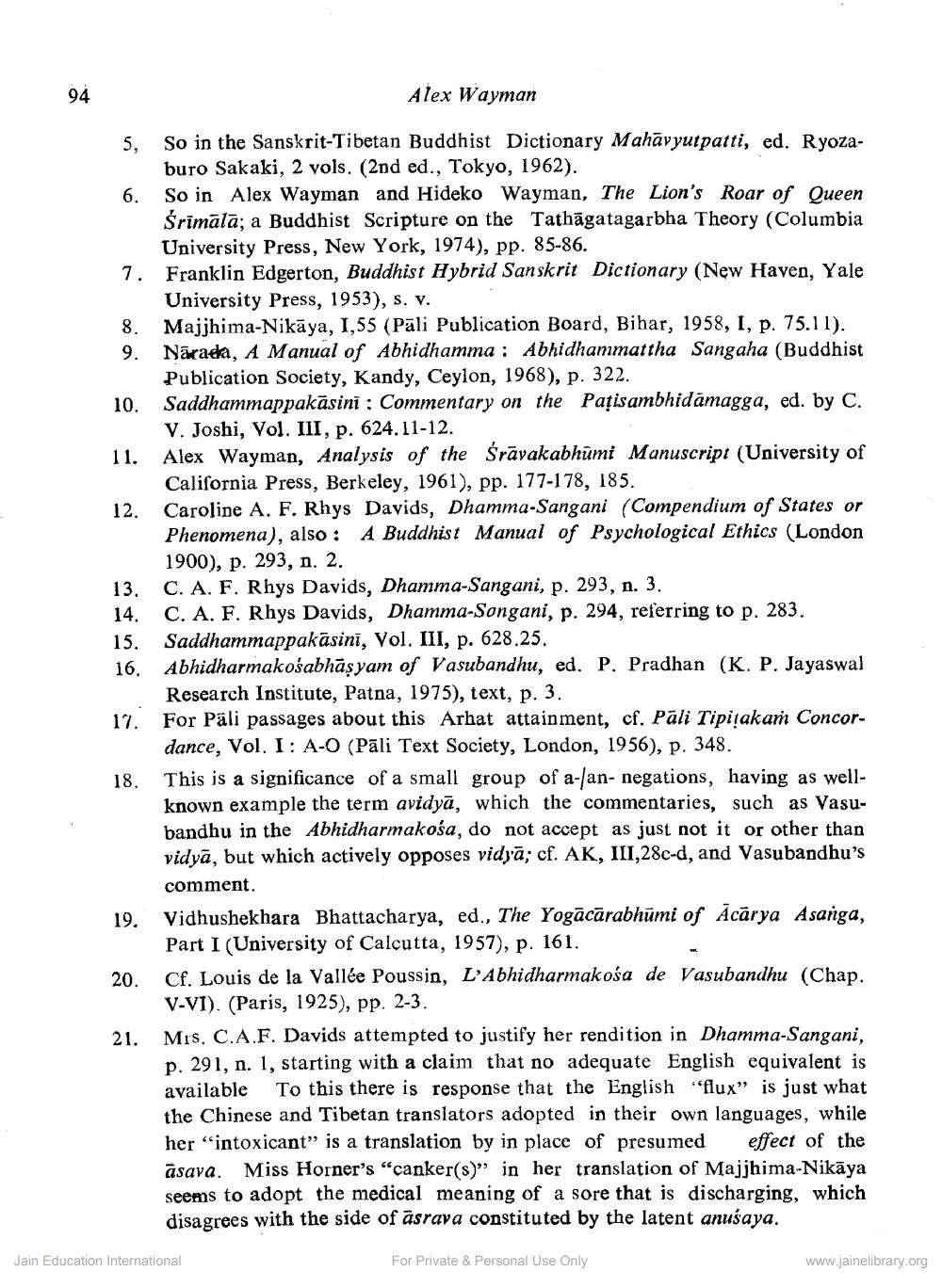________________
Alex Wayman
9.
11.
Alex
5, So in the Sanskrit-Tibetan Buddhist Dictionary Mahāvyutpatti, ed. Ryoza
buro Sakaki, 2 vols. (2nd ed., Tokyo, 1962). 6. So in Alex Wayman and Hideko Wayman, The Lion's Roar of Queen
Śrimāla; a Buddhist Scripture on the Tathāgatagarbha Theory (Columbia
University Press, New York, 1974), pp. 85-86. 7. Franklin Edgerton, Buddhist Hybrid Sanskrit Dictionary (New Haven, Yale
University Press, 1953), s. v. 8. Majjhima-Nikaya, I,55 (Pali Publication Board, Bihar, 1958, I, p. 75.11).
Nārada, A Manual of Abhidhamma : Abhidhammattha Sangaha (Buddhist
Publication Society, Kandy, Ceylon, 1968), p. 322. 10. Saddhammappakāsini : Commentary on the Pațisambhidāmagga, ed. by C.
V. Joshi, Vol. III, p. 624.11-12. Alex Wayman, Analysis of the Śrāvakabhūmi Manuscript (University of
California Press, Berkeley, 1961), pp. 177-178, 185. 12. Caroline A. F. Rhys Davids, Dhamma-Sangani (Compendium of States or
Phenomena), also: A Buddhist Manual of Psychological Ethics (London
1900), p. 293, n. 2. 13. C. A. F. Rhys Davids, Dhamma-Sangani, p. 293, n. 3. 14. C. A. F. Rhys Davids, Dhamma-Songani, p. 294, referring to p. 283. 15. Saddhammappakasini, Vol. III, p. 628.25. 16. Abhidharmakośabhāsyam of Vasubandhu, ed. P. Pradhan (K. P. Jayaswal
Research Institute, Patna, 1975), text, p. 3. 17. For Pāli passages about this Arhat attainment, cf. Pāli Tipitakaṁ Concor
dance, Vol. I: A-O (Pāli Text Society, London, 1956), p. 348. 18. This is a significance of a small group of a-an- negations, having as well
known example the term avidyā, which the commentaries, such as Vasubandhu in the Abhidharmakośa, do not accept as just not it or other than vidyā, but which actively opposes vidyā; cf. AK, III,28c-d, and Vasubandhu's
comment. 19. Vidhushekhara Bhattacharya, ed., The Yogācārabhūmi of Ācārya Asanga,
Part I (University of Calcutta, 1957), p. 161. 20. Cf. Louis de la Vallée Poussin, L’Abhidharmakośa de Vasubandhu (Chap.
V-VI). (Paris, 1925), pp. 2-3 21. Mis. C.A.F. Davids attempted to justify her rendition in Dhamma-Sangani,
p. 291, n. 1, starting with a claim that no adequate English equivalent is available to this there is response that the English "flux” is just what the Chinese and Tibetan translators adopted in their own languages, while her "intoxicant” is a translation by in place of presumed effect of the asava. Miss Horner's “canker(s)” in her translation of Majjhima-Nikāya seems to adopt the medical meaning of a sore that is discharging, which disagrees with the side of asrava constituted by the latent anuśaya.
Jain Education International
For Private & Personal Use Only
www.jainelibrary.org




